
8
Français MODE D’EMPLOI
Ce dispositif est fourni stérile. Tout le matériel contenu à l’intérieur de la poche à barrière stérile (le système de mise en place et le stent
[Figure 1], ainsi que le plateau et la doublure de la poche) est stérile. Ni la surface extérieure de la poche à barrière stérile ni la boîte
en carton du produit ne doivent être considérées comme étant stériles.
DESCRIPTION DU DISPOSITIF
Le système de stent vasculaire
®5Festconçupourlamiseenplaced’unstentauto-expansibledanslesystèmevasculaire
périphériqueaumoyend’unsystèmedemiseenplacemunid’unegaine.Lesystèmedestentvasculaire
® 5F se compose
des éléments suivants :
• Unstentauto-expansibleimplantableennitinol(alliagenickel-titane),illustrésurlaFigure2.Ils’agitd’uneprothèsesoupleà
finesmaillestubulaires,deformehélicoïdale,quiatteintsondiamètrefinal(sanscontrainte)lorsqu’ilsedéploiedanslevaisseau
cible.Lorsdudéploiement,lestentexerceuneforceradiale,dirigéeversl’extérieur,surlasurfaceluminaleduvaisseauafind’en
établirlaperméabilité.Autotal,lestentcomporte12marqueurssituésauxextrémitésdustent,sixàchaqueextrémité.Troisà
chaqueextrémitésontdesmarqueursradio-opaquesentantale(1A)ettroissontennitinol(alliagenickel-titane)(1B).
1A 1B 1B
1A
Figure 2 : Stent vasculaire
®
• Unsystèmedemiseenplacecoaxialàtroisaxes(Figure1)composéd’untubeinternequicontientlalumièreduguide,une
gainedemiseenplacedustent(D+E)etunegainedestabilisationdusystème(C),tousreliésparl’intermédiaired’une
poignée.Ducôtéproximal,lalumièreduguidecommenceauniveaud’unraccordLuer(B)etsetermineducôtédistalavec
l’extrémitéatraumatiqued’uncathéter(A).Lalumièreduguidepermetd’accepterunguidecompatiblede0,035po(0,89mm).
Lestentauto-expansibleestcontenudansl’espacecomprisentrelalumièreduguideetlagainedemiseenplacedustent.Le
systèmedemiseenplacelimitelesmouvementsinvolontairesdustentpendantleretraitdelagaine.Avantledéploiement,le
curseurdeverrouillagedesécurité(F)doitêtredébloqué.Ledéploiementdustentestdéclenchéentournantlagrandemolette
(G)situéesurlapoignée.Pourrétracterlecathéterdistal,utilisersoitlagrandemolettepourundéploiementlentdustent,soitla
petitemolette(H)pourundéploiementplusrapidedustent.
Le système de graduations
®estune règlegraduée non radio-opaquesituéesur lecorps du cathéterqui mesure la
distance depuis l’extrémité distale. Les graduations
®sontindiquéespardesbandesplacéessurlecorpsducathéter
àintervallesde1cm.Ladistancedepuisl’extrémitédistaleducathéterestmarquéetousles10cm.Lesbandespluslarges
indiquentlepointàmi-chemin(5cm)entrelesdistancesmarquées(Figure3).Lesystèmedegraduations
® fournit un
repère intravasculaire pour l’emplacement de l’extrémité distale du cathéter. Le système de graduations
® peut également
faciliterl’alignementd’undispositifthérapeutiquesupplémentairecomportantlemêmesystèmedegraduations
®.
Remarque : Le système de graduations
®fournituneapproximationquipeutnepasêtreunereprésentationexacte
deladistancevéritablementparcourueàl’intérieurduvaisseauetquidoitdoncêtreconfirméesousguidageradioscopique.Le
système de graduations
®comportedesgraduationsdecouleurblanchenonradio-opaquesquisontconçuespourêtre
utilisées en dehors de la gaine.
1 cm
10 cm
5 cm
Figure 3 : Système de graduations
® sur le corps du cathéter du système de stent vasculaire
® 5F
INDICATIONS
Le système de stent vasculaire
® 5F est conçu pour améliorer le diamètre luminal dans le cadre du traitement des lésions
symptomatiquesde novo ou de resténose dans l’artère fémorale superficielle native et l’artère poplitée.
CONTREINDICATIONS
Le système de stent vasculaire
®5Festcontre-indiquédanslescassuivants:
• Patientsprésentantunehypersensibilitéconnueaunitinol(alliagenickel-titane)etautantale.
• Patientsnepouvantpasbénéficierdutraitementantiplaquettaireet/ouanticoagulantrecommandé.
• Patientsprésentantunethromboseaiguëousubaiguëimportanteàproximitédelalésioncible.
• Patientsprésentantunelésionsusceptibled’empêcherlegonflageintégrald’unballonnetd’angioplastieoulamiseenplace
correcte du stent ou du système de mise en place du stent.
AVERTISSEMENTS
• Lesystèmedestentvasculaire
® 5F est fourni STÉRILEetestréservéàunUSAGE UNIQUE.
• NE PAS RESTÉRILISER ET/OU RÉUTILISER le dispositif.
• Laréutilisation,larestérilisation,leretraitementet/oulereconditionnementpeuventexposerlepatientoul’utilisateuràunrisque,
provoqueruneinfectionoucompromettrel’intégritéstructurelleet/oulescaractéristiquesmatériellesetconceptuellesessentielles
dudispositif,cequiestsusceptibled’entraînerunedéfaillancedudispositifet/oudeslésions,unemaladievoireledécèsdupatient.
Laréutilisationdecedispositifmédicalcomporteunrisquedetransmissioncroiséeentrelespatients,danslamesureoùles
dispositifsmédicaux–notammentceuxquiprésententdepetitesetgrandeslumières,desjointureset/oudesespacesentre
lescomposants–sontdifficilesvoireimpossiblesànettoyerunefoisquelesliquidesoutissusbiologiqueséventuellement
contaminéspardesagentspyrogènesoumicrobienssontentrésencontactavecledispositifmédicalpendantunedurée
indéterminée.Lematérielbiologiquerésiduelpeutfavoriserlacontaminationdudispositifpardesagentspyrogènesoudes
micro-organismes,cequipeutentraînerdescomplicationsinfectieusesvoireledécès.
• NE PAS utiliser si la poche est ouverte ou endommagée.
• NE PAS utiliser le dispositif aprèsladatelimited’utilisation«Àutiliseravant»indiquéesurl’étiquette.
• Lespersonnesallergiquesaunitinol(alliagenickel-titane)peuventégalementdévelopperuneréactionallergiqueàcetimplant.
• NE PASexposerlesystèmedemiseenplaceàdessolvantsorganiques(p.ex.del’alcool).
• Lestentn’estpasconçupourêtrerepositionnéourécupéré.
• Lamiseenplaced’unstentdansunegrossebranchepeutêtreàl’originededifficultéslorsdeprocéduresdiagnostiquesou
thérapeutiquesfutures.
• Encasdetraitementparmiseenplacedeplusieursstentsquisechevauchent,lacompositiondecesstentsdoitêtreidentique
(p.ex.nitinol[alliagenickel-titane]).
• Ilestrecommandéd’utiliserledispositifayantunelongueurutilede80cmpourlesprocédureshomolatérales.Lalongueur
utilelapluslongue dudispositif,quiestde135 cm,peut s’avérerproblématiquepourl’utilisateurquidoitmaintenirle
dispositif en position droite durant les procédures homolatérales. Ne pas être en mesure de maintenir le dispositif en position
droitepeutempêcherlebondéploiementdel’implant.
• Leseffetsàlongtermedeladilatationàrépétitiondestentsendothélialisésnesontpasconnus.
PRÉCAUTIONS
• Cedispositifdoitêtreutilisépardesmédecinsayantreçuuneformationappropriée.
• Pendantlerinçagedusystème,vérifierquelasolutionsalinesortauniveaudel’extrémitéducathéter.
• Lesystèmedemiseenplacen’estpasconçupourêtreutiliséavecdessystèmesd’injectionsouspression.
• Toutnouveaufranchissementd’unstentpartiellementoucomplètementdéployéavecdesdispositifssupplémentairesdoit
être effectué avec précaution.
• Maintenirle dispositifleplusdroitpossibleaprèssonretraitdel’emballageetlorsde son introduction dans lecorpsdu
patient.Lenon-respectdecetteindicationpeutempêcherlebondéploiementdel’implant.
• Avantetpendantledéploiementdustent,faireensortequelecathéterdusystèmedemiseenplacesoitsuffisammenttendulorsqu’il
setrouveàl’extérieurducorpsdupatiententenantdélicatementlagainedestabilisationetenlamaintenantdroiteettendue.
• Encasderésistanceexcessivependantledéploiementdustent,NE PAS exercer de force sur le système de mise en place.
Retirer le système de mise en place et le remplacer par une unité neuve.
• Conserverdansunendroitfraisetsec,àl’abridelalumière.
• NE PAStenterdecasser,d’endommageroudedéplacerlestentaprèssamiseenplace.
• Des cascliniquesde fractureontété signalésavecle stent vasculaire
®.Ces cassesont produits dansdes lésions
modérémentàsévèrementcalcifiées,enamontouenavald’unezonedechevauchementdestents,etencasd’allongement
>10%desstentsaumomentdudéploiement.Parconséquent,ilconvientdefairepreuvedeprudencependantledéploiement
dustent,carlamanipulationdusystèmedemiseenplacepeutentraîner,dansderarescas,l’allongementdustentconduisant
àlafracturedustent.Lesimplicationscliniquesàlongtermedecesfracturesdestentn’ontpasencoreétéétablies.




























